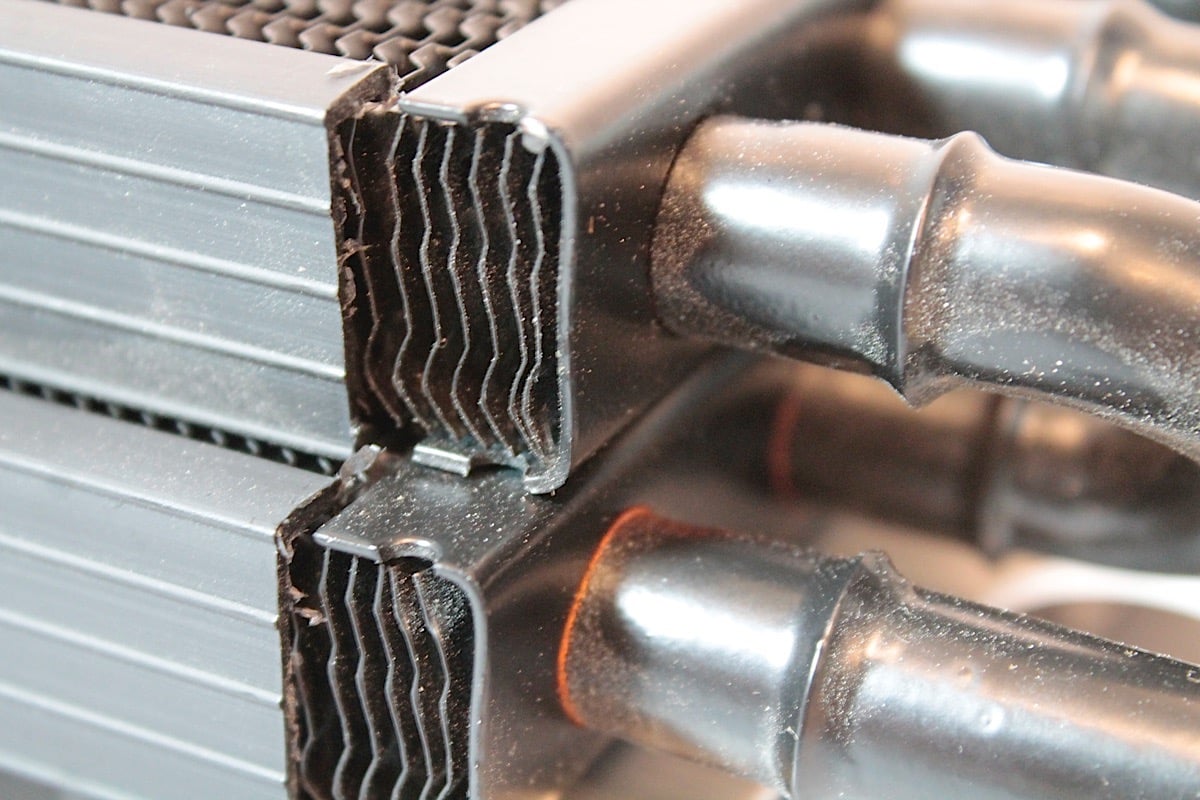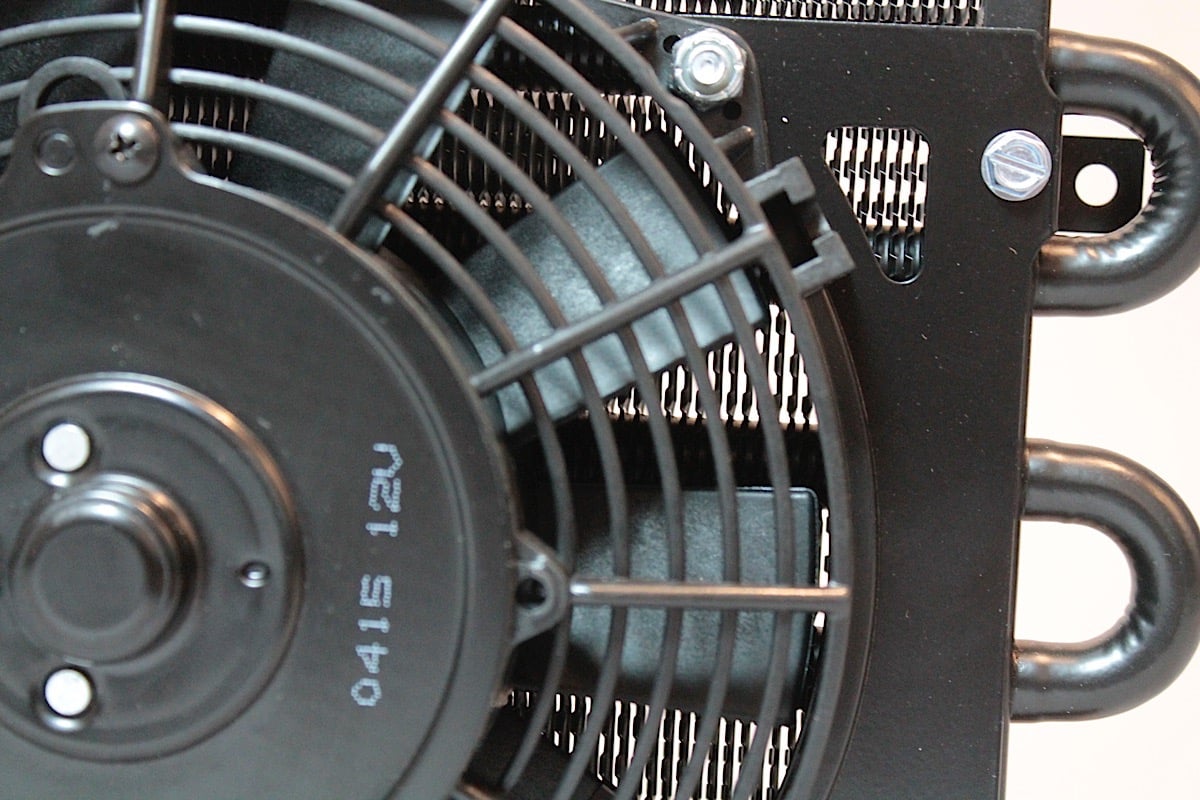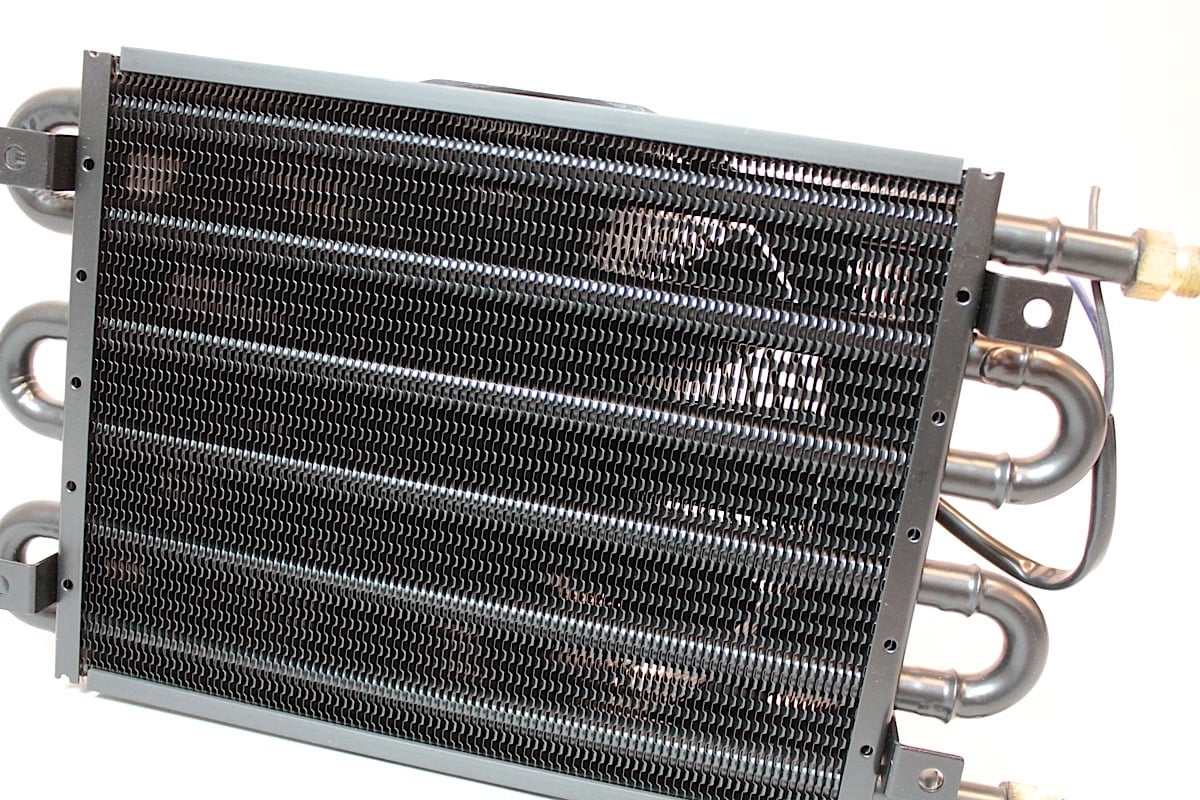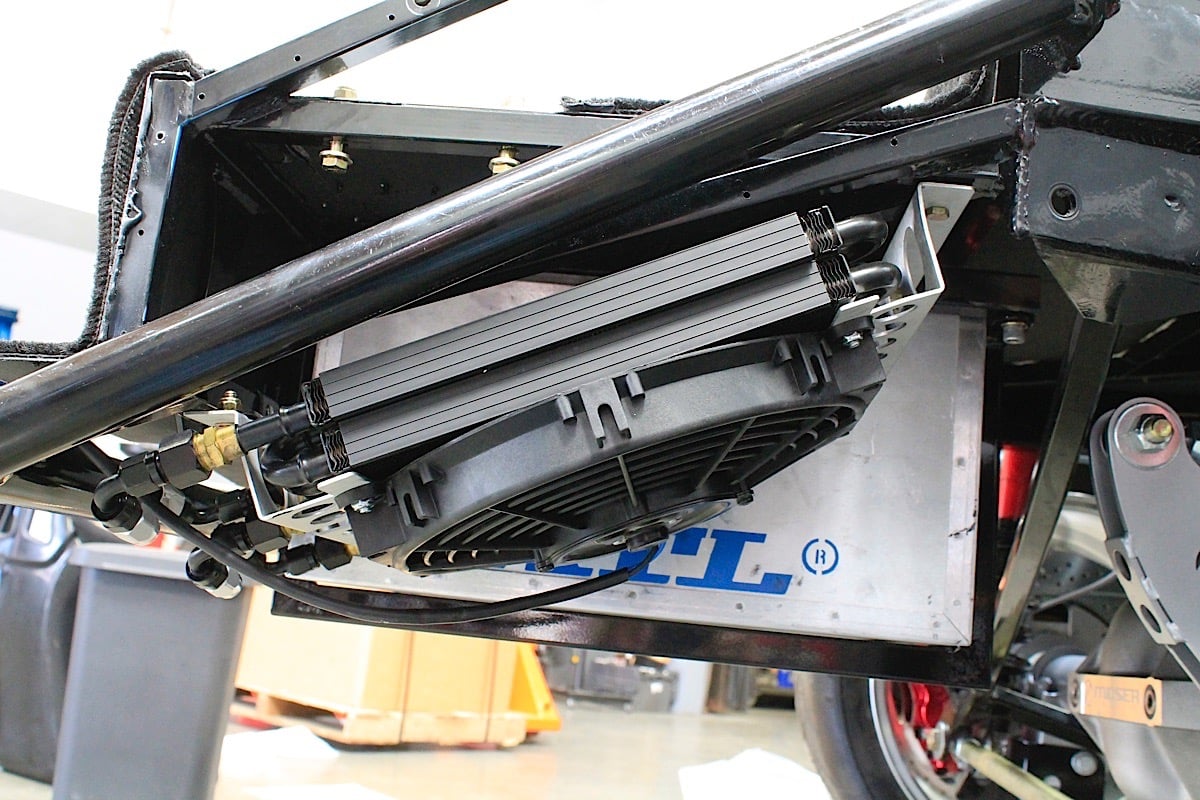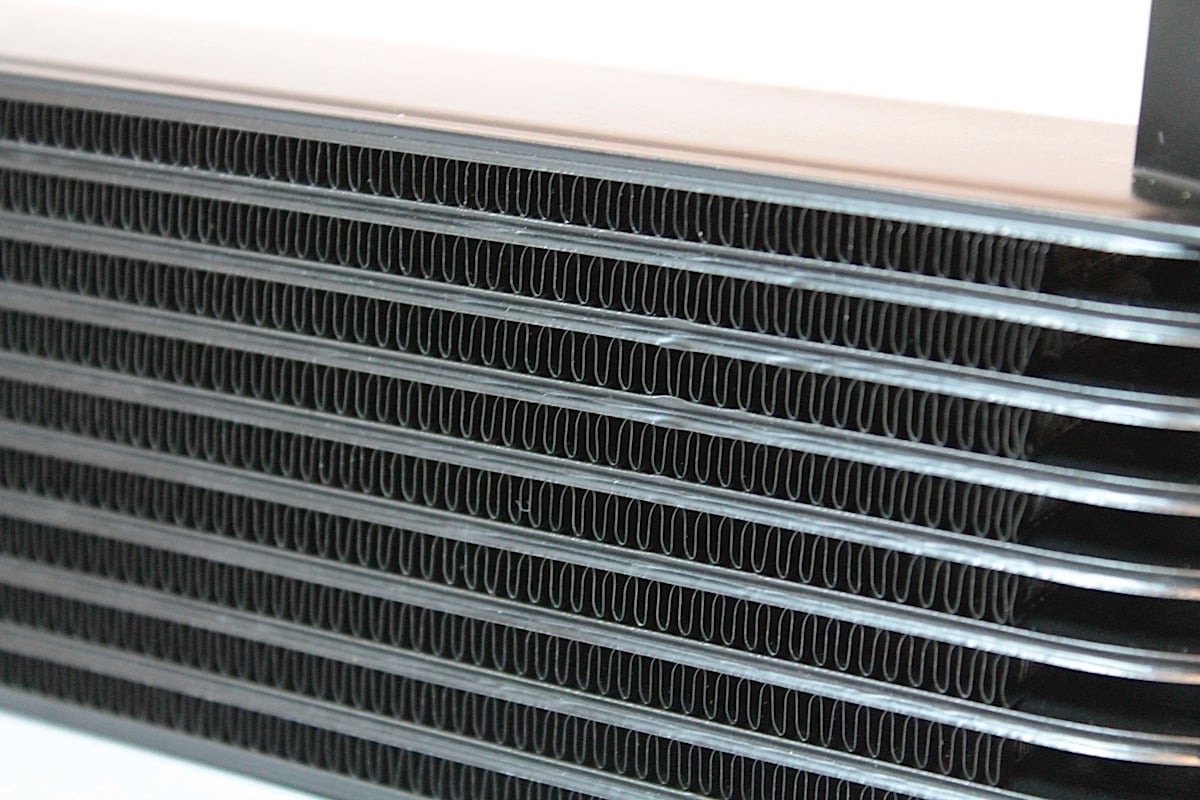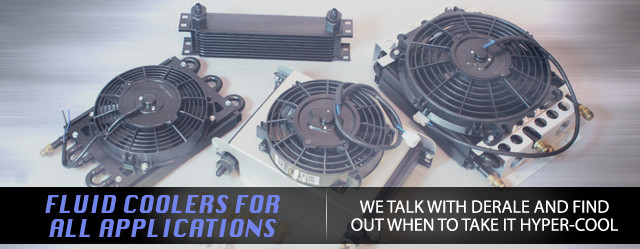 Many cars on the road today have some sort of external fluid cooler, usually for the transmission or the power steering. While some systems don’t require an external cooler for normal, daily driving, the benefits from such a cooler can help protect the systems those coolers are applied to, and prolong the life of those components.
Many cars on the road today have some sort of external fluid cooler, usually for the transmission or the power steering. While some systems don’t require an external cooler for normal, daily driving, the benefits from such a cooler can help protect the systems those coolers are applied to, and prolong the life of those components.
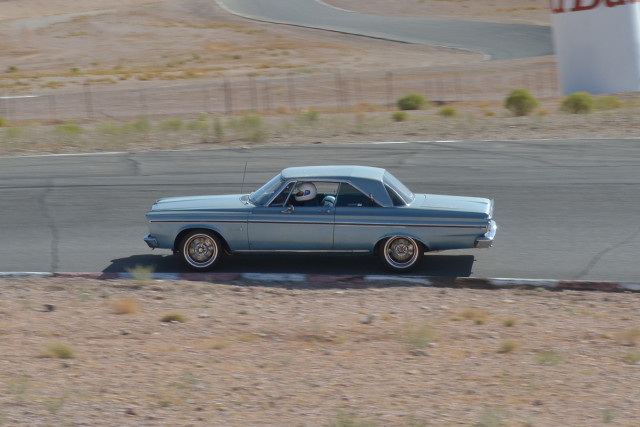
Racing a classic car at the track means much higher temperatures for power steering, transmission, and oil. A dedicated fluid cooler should be considered.
In older classic cars, the main function of the radiator was to help keep the engine running cooler, and for vehicles with an automatic transmission the radiator served double-duty as a transmission fluid cooler. While this system is still being used today, we are finding that separate, dedicated coolers are becoming more popular for performance and towing applications.
We’ll take a look at external fluid coolers from Derale Performance, and show you the three main types of fluid coolers that it offers. Whether you drive your vehicle daily or use it for occasional weekend warrior duties at the race track, Derale has a cooler for nearly any automotive application to benefit your vehicle’s performance.
Derale Performance is well known in the performance community; they’ve been around since 1946 and have been a charter member of SEMA (Specialty Equipment Marketing Association), established in 1963. Today, this California company still prides itself on adhering to the core principles that founder Sam Longo practiced throughout his career.
There are three types of coolers available from Derale: tube and fin, plate and fin, and stack plate. Some include dedicated electric fans to facilitate remote mounting applications.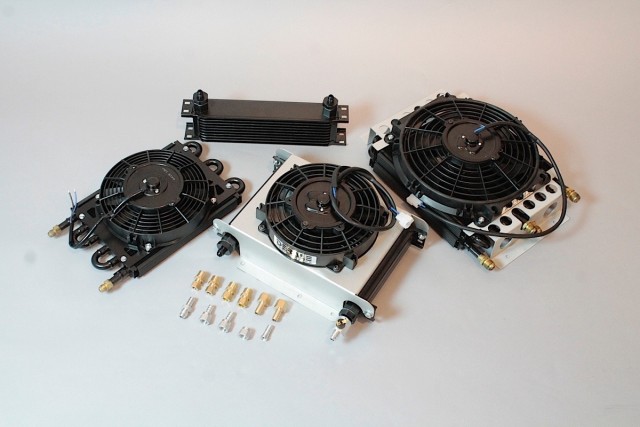
Why Do I Need An External Cooler?
Like our body, many automobile components, like the transmission or power steering system, work most efficiently at operating temperature. A transmission works best at 175-200 degrees. When the temperature is too low, moisture can build and the transmission loses efficiency; when the temperature is too high, the fluid begins to break down. The same holds true for the power steering system, so getting the fluid to operating temperature is done by simply driving the vehicle – keeping it at operating temperature when you’re pushing the vehicle a little harder than normal is aided by using an external cooler.
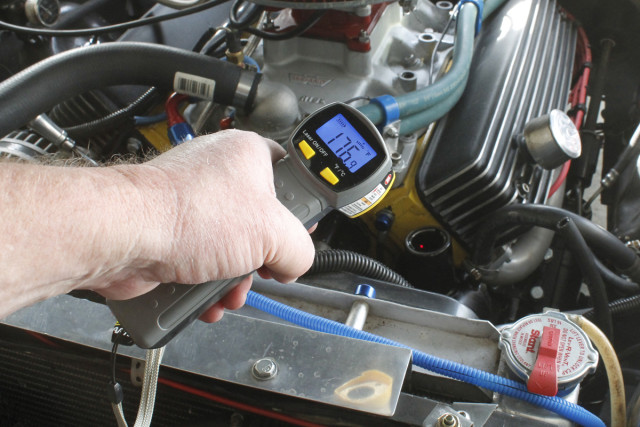
This is the temperature inside the reservoir after driving around the block. One more trip with a cooler dropped it eight degrees.
As performance and horsepower are increased, you can imagine that temperatures can increase as well. This can include towing a trailer, racing on or off road, or higher speeds in a hotter climate. As we mentioned, for daily driving under normal conditions the factory supplied cooling systems are adequate and were designed for that specific vehicle and the type of driving expected. But as gearheads, we don’t do “stock” daily drivers, we want more performance.
We talked to Mike Murphy from Derale Performance about external cooling systems and how to choose the right system. He had this to say, “Each cooler is a case-by-case scenario. There’s no real way to put a label on a vehicle and decide what cooler is best for it until we know how the vehicle is used.”
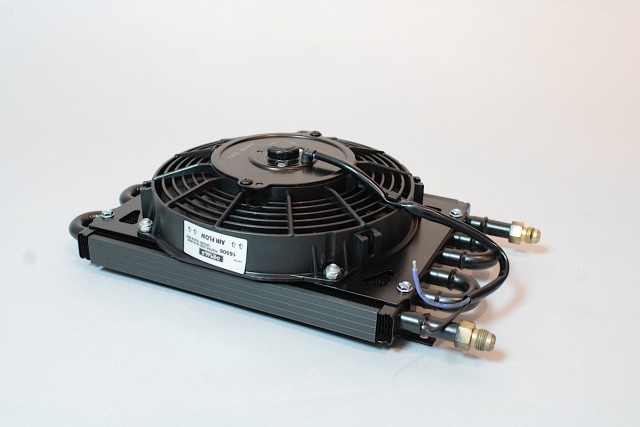
Derale can provide coolers that mount in front of the radiator, or remote mounted like this Dyno-Cool remote transmission cooler.
“Towing a trailer in Alaska might be quite a bit different from towing the same trailer in Arizona,” Murphy said. “Engine coolers depend on where the engine spends most of its time. Running at 3,500 rpm or more for extended periods means that an external oil cooler is a good idea to help keep the oil temperature down.”
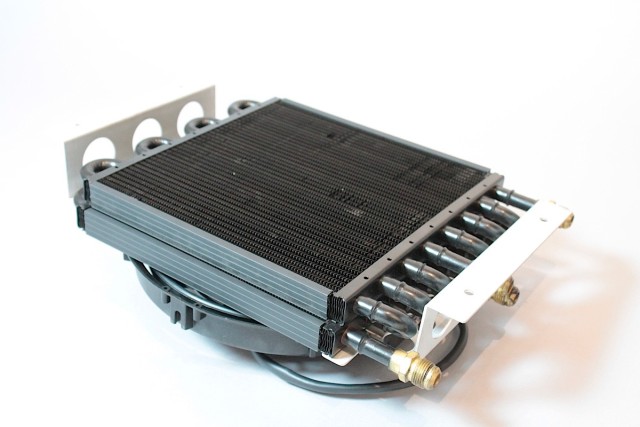
A dual-circuit Electra-Cool cooler like this can be used to cool two components. We used this one as a transmission and differential cooler on a project car.
When you push your car a little harder than typical, daily driving, an external cooler is not only a great idea, Derale recommends it. Maintaining operating temperature is greatly enhanced with an external cooler because it draws the fluid out of the component and allows it to cool slightly before entering the component again. This reduction in temperature can also keep the fluid from boiling, or foaming up, from the excessive heat.
But you can also have too much of a cooler. Murphy said, “Too much or too little of a cooler can have detrimental affects on a transmission. Running a transmission at 140 degrees can do just as much damage as running it at 240 degrees.” This is why Derale suggests that customers contact them so they can help choose the right cooler style and size.
We live in the cooling industry, we specialize in this industry and dedicate our career to keeping fluids at operating temperatures. -Mike Murphy, Derale Performance
Murphy told us that he comes across people who will say they are only towing a motorcycle trailer, but if they’re always pulling the trailer up a grade that can make a difference. The weight of the motorcycle – and everything else in the trailer – can put even more stress on a transmission. People sometimes don’t realize how much extra weight is added.
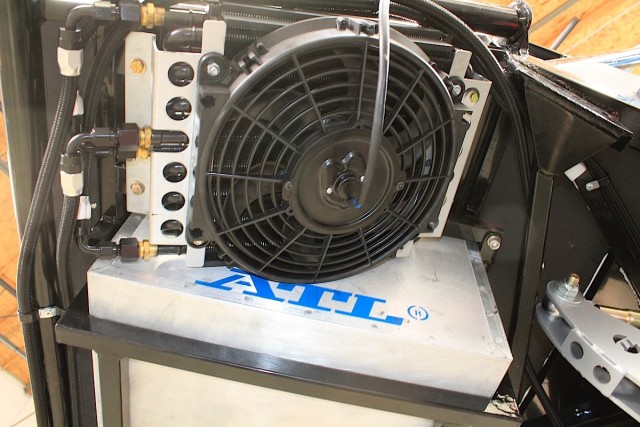
How is this for remote mount? Mike Murphy says this isn’t a problem because Derale does the math and provides the right fan and spacing to provide the necessary cooling for this application.
The same holds true for occasional trips to the race track: saying you race a couple times a year doesn’t mean you won’t need a fluid cooler. Those couple of times may require a fluid cooler; there’s no average when it comes to choosing a cooler. Adding a cooler for two race days is better than taking a chance just because you don’t need it the rest of the year.
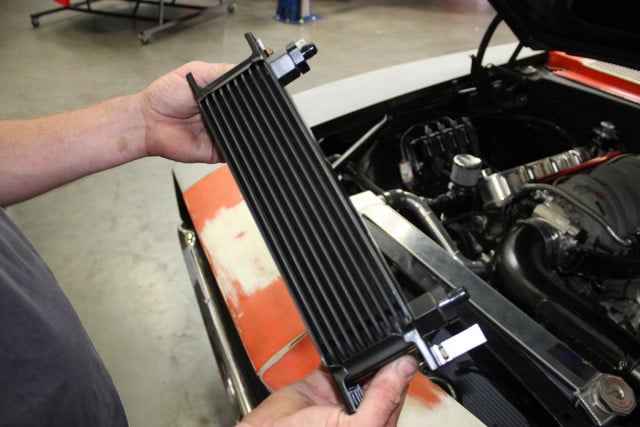
This stack plate cooler is compact enough for fitting in front of the radiator and provides excellent cooling for the power steering.
Even for power steering there are some benefits from using an external cooler. However, that is also based on how and when the car is driven. Many factory coolers are simply a single- or double-pass tube that routes in front of the radiator. That doesn’t cut it for performance applications.
We experimented with a power steering cooler earlier this year and on a simple trip around the block we were able to drop the fluid temperature inside the power steering pump by eight degrees. While it may not seem like much, that’s nearly a five percent reduction after just driving around the block. While results can vary, this is just to illustrate how adding an external cooler can impact even the most minimal thing that you do with your vehicle (driving around the block).
Various styles, shapes and sizes are available from Derale, there are hundreds to choose from.
Three Types Of Coolers: Tube And Fin, Plate And Fin, Stack Plate
Most everyone is familiar with external transmission coolers; walk into nearly any auto parts store and you can find a dedicated transmission cooler on the shelves. These coolers, called tube and fin style coolers, are flat with a single tube that serpentines through a series of aluminum cooling fins.
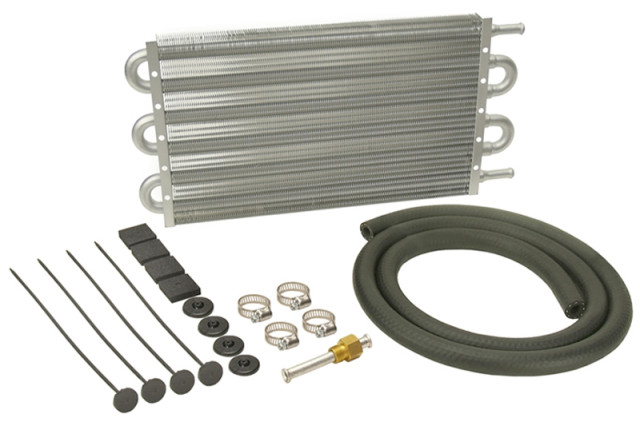
The typical tube-and-fin type transmission cooler kit is usually the kind of cooler people add when they start towing, but one size doesn’t fit all.
They are often listed as add-ons for towing applications, but there are two things to remember about this style of cooler: they are not only used for towing applications, nor are they designed to compensate for overloaded vehicles. They should only be added for light- to medium-duty applications.
The tube and fin style coolers are perfectly acceptable in many street applications where a vehicle is not driven hard. The most affordable type of cooler, they are often mounted in front of the radiator where the surface air is the greatest as it passes through the grille. Made with either aluminum or copper tubing, these coolers are far more than just a bent tube with fins attached.
As the fluid enters this type of cooler, turbulators inside the tubes agitate the fluid and convert the laminar flow into a turbulent flow. This turbulence forces more of the fluid to come in contact with the tubing for maximum heat transfer. The aluminum fins on this type of cooler help to draw the heat away from the tubes, and the cooler air passing by helps to reduce fluid temperatures.
For typical every day driving and light performance, the tube and fin cooler will help keep the temperatures down, and prolong fluid and component life. Tube and fin style coolers can be used for transmission or power steering applications, and they are available as a two-pass cooler (typical for power steering) to a multiple-pass cooler (typical for transmissions). However, the tube and fin style cooler is the least efficient style of cooler, therefore, they are best suited to light duty service.
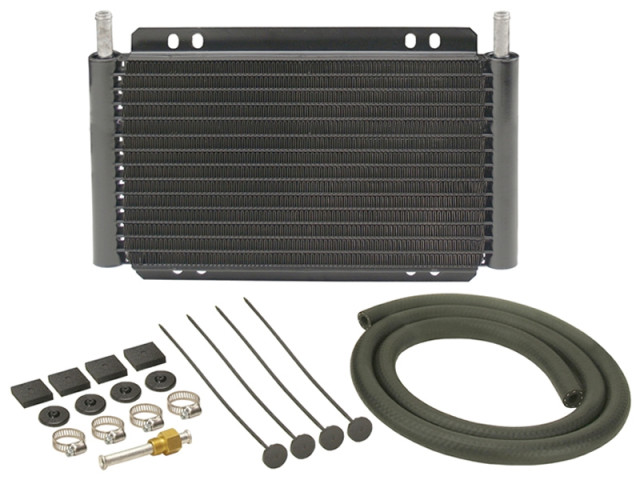
The plate and fin style cooler is the medium-duty cooler for applications that aren’t quite race track-ready, but require more efficient cooling than a standard cooler.
The next step up is the plate and fin style cooler. These coolers are good for medium duty applications and have more efficient cooling properties. They also have agitation like the tube and fin style, but the fluid is forced through smaller, flatter plates which allows more contact with the aluminum surface inside the cooler. This cooler would be a step up for medium duty towing or for healthier musclecars that are driven a little harder than normal, every day driving.
Finally, the stack plate cooler is the most efficient of the three styles. They have a similar design to the plate and fin style coolers, but have high-flow turbulaters inside the tubes for racing or heavy duty towing applications. This is the type of cooler recommended for engine oil and transmission cooling applications, and the smaller units are perfect for power steering applications.
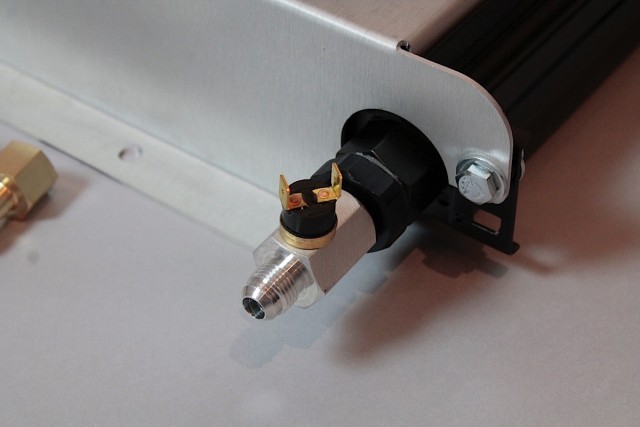
The AN fittings on the stack plate cooler allow for easier removal for racing applications on the stack plate cooler. This thermostatic switch allows the cooling fan(s) to switch on and off based on a preset temperature.
You’ll also notice the AN fittings on the stack plate cooler, a popular type of hose attachment in the high-performance and racing industry. This also allows for quicker removal for vehicles that tend to have hoses and coolers removed more frequently than the two other styles of coolers. It also allows for better connections for high pressure tubes and hoses, providing better security than the standard worm-gear hose clamp can provide.
All of these coolers can provide a separate function for your vehicle; whether it’s light to heavy towing, street/strip to open track racing, and from power steering to cooling the differential fluid, there are more choices than you can imagine, and listing them here would take the rest of the day – or week!
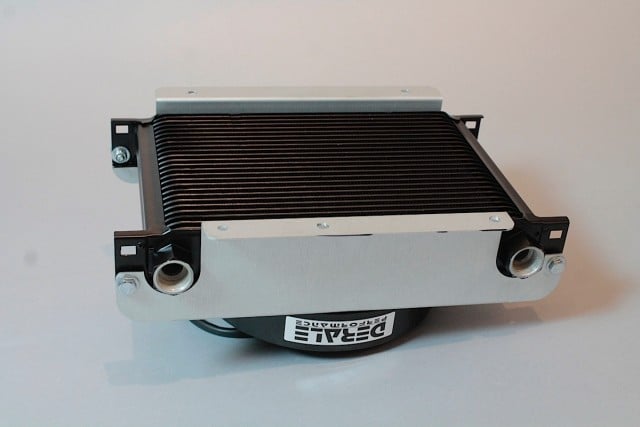
The aluminum mounting plate on the remote-mount coolers space the cooler away from flat sheet metal to allow the proper amount of air flow when the fan kicks on.
The remote mount coolers that Derale offers include an aluminum mounting plate and electric cooling fan. These coolers are designed for applications where there isn’t room to mount the cooler in front of the radiator. Murphy assures us, “We’ve done the math for you. We know how much space needs to be between the cooler and the mounting location, and the fan is factored in to provide enough air flow to properly cool the fluid.”
This means that mounting this type of cooler under a floor pan doesn’t require the air to pass through it as a typical cooler requires. The fans are typically themostatically controlled, and when wired up using a 30-amp relay the fan will only function when the set temperature is reached, and the fan will shut down when the fluid cools. This type of setup solves a lot of space problems by allowing the cooler to be mounted horizontally under the car, or in a tight compartment, providing the hot air exiting the fan has somewhere to go.
Top: For components that don't have an internal pump, like differentials and manual transmissions, a separate pump is required to cycle the fluid.
Bottom: Fin spacing, fan blade style, and size are all factored in to lower the temperature of the fluid passing through the coolers.
As you can tell, the various styles and types of coolers don’t have any specific application applied to them because each application can vary. The best way to match up the customer to a cooler is to start with the application, and build from there and select a cooler. As Murphy said, they live in this industry and they are ready to help match up the right cooler to the level of performance. So check out the Derale Performance website for its complete line of coolers, and give them a call if you find yourself lost – they’ll help you keep your cool and get back out on the road with confidence.



